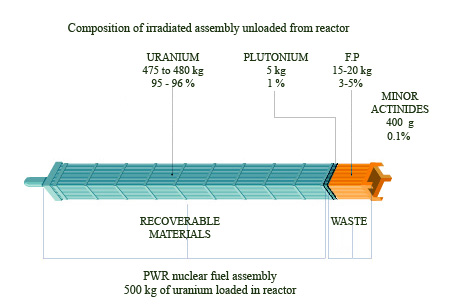Spent fuel can still generate a lot of energy
The fuel removed from a reactor core after three or four years of irradiation is still extremely radioactive. For non-specialists, it is all just hazardous waste. But by law, and for the experts, a distinction must be made between radioactive waste and recoverable materials, as some of this spent fuel can be put to good use.
After irradiation, uranium oxide fuel enriched with fissile U-235 still contains 950 kg of uranium, 35 to 40 kg of fission products, 10 kg of plutonium and 800 g of minor actinides (these figures are for a PWR under normal operating conditions). What can be done with these four materials?

Waste and recoverable materials
When extracted from a reactor under normal operating conditions, a fuel assembly is made up of four components: 1) Uranium, which can be recycled in fresh fuel; 2) Plutonium, which have very high energy potential; 3) Fission products (FP), which are pure waste; 4) Minor actinides other than plutonium currently considered also as waste. During the first years, the very high levels of radioactivity resulting from irradiation are due to fission products, and later to plutonium.
© AREVA
Uranium The uranium removed from a reactor is similar to that used to fuel the reactor. It has a depleted fissile isotope content, but most of the uranium-238 isotopes, which account for most of the tonnage, are still intact. This uranium is not very radioactive. Separating it from the spent fuel divides the mass of waste by 20. Some of this recovered uranium is currently reused in France to make fresh fuel. It could be used in the distant future to generate energy in reactors known as Generation IV reactors.
Fission productsFission products , which account for 3.5 to 5% of the mass, are considered as pure waste. They are responsible for almost all the initial radioactivity. While steps must be taken to prevent them from spreading, their radioactivity is divided by more than a thousand during the first 300 years.
, which account for 3.5 to 5% of the mass, are considered as pure waste. They are responsible for almost all the initial radioactivity. While steps must be taken to prevent them from spreading, their radioactivity is divided by more than a thousand during the first 300 years.
Plutonium Representing only 1% of the total mass, plutonium-239 is a strategic material that is both sought-after and feared. Produced in a military reactor, it can be used to make nuclear weapons. Produced in a civil reactor, it is an extraordinary source of energy. If ingested, plutonium is far more toxic than any fission product. When buried as waste, its radiotoxicity predominates after 50 years in spent fuel that has not been reprocessed.
is a strategic material that is both sought-after and feared. Produced in a military reactor, it can be used to make nuclear weapons. Produced in a civil reactor, it is an extraordinary source of energy. If ingested, plutonium is far more toxic than any fission product. When buried as waste, its radiotoxicity predominates after 50 years in spent fuel that has not been reprocessed.
Minor actinides Minor actinides (neptunium, americium, curium) are currently considered as waste. Like plutonium, they are radiotoxic. Despite their low proportion (0.08%), their radiotoxicity exceeds that of fission products after about 100 years. They are heavy, fragile nuclei. Generation IV reactors could destroy them to generate energy, in which case they would be “promoted” from waste to recoverable materials.
(neptunium, americium, curium) are currently considered as waste. Like plutonium, they are radiotoxic. Despite their low proportion (0.08%), their radiotoxicity exceeds that of fission products after about 100 years. They are heavy, fragile nuclei. Generation IV reactors could destroy them to generate energy, in which case they would be “promoted” from waste to recoverable materials.
Learn more :
Recoverable materials
Spent nuclear fuel
Fuel reprocessing
Uranium 238 and 235
Plutonium 239
Future Reactors
Other articles on the subject « The waste issue »
Fuel Reprocessing
The spent fuel reprocessing option Spent fuel reprocessing is derived from a process called the P[...]
Alternative to reprocessing
Leave fuel as it is : do not reprocess If the spent fuel does not undergo reprocessing, the fuel [...]
What to do with plutonium
A highly strategic material and a hazardous type of waste What becomes of plutonium is central to[...]
Plutonium options
Plutonium: hazardous waste or miraculous raw material? For those who advocate pulling out of nucl[...]
Costs comparison
Reprocessing or not reprocessing: a comparison Which option for dealing with spent fuel from reac[...]